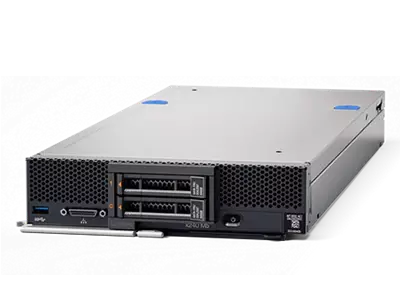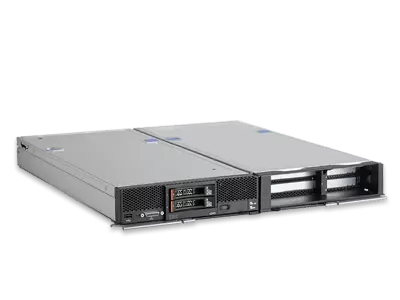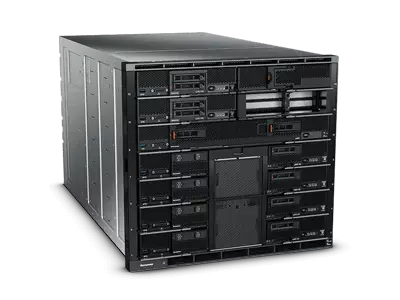Lenovo blade servers are the most advanced servers on the market today. As the workhorses of the server market, our blade servers are meant to streamline operations and conserve as much space as possible. A Lenovo blade server has up to 80% better density than a standard rack server deployment, which makes it highly effective with a smaller footprint. Blade servers can be the foundation for your on-premise cloud server or virtualization server environment, with on-board networking and dense memory deployments.
We pride ourselves on high-performing 2-socket and 4-socket blade servers that feature strong security, efficiency, and reliability. Our networking and chassis options are designed to accommodate any business needs.
What is a Blade Server?
A blade server is a compact, powerful server that can be used for a variety of purposes. Blade servers are designed to be highly efficient and use less energy than traditional servers. They are also easy to maintain and can be quickly deployed. Blade servers are often used in data centers and other high-performance computing environments. Blade servers are an increasingly popular option for businesses that need powerful, yet compact and energy-efficient servers. These types of servers are perfect for data centers and other high-performance computing environments where space and power usage are important considerations. Additionally, blade servers are relatively easy to maintain since they have fewer components than traditional servers. And they can be quickly deployed which makes them ideal for businesses that need to scale their server infrastructure quickly.
What is the difference between rack server and blade server?
The fundamental difference between a rack server and a blade server is that a rack server is a standalone server mounted in the case, but a blade server must collaborate with other blade servers in a single server chassis. Rack servers and blade servers are both types of hardware that can be used to run a variety of software applications. The main difference between the two is that rack servers are typically more expensive and offer more features than blade servers. Blade servers also tend to be more energy-efficient, which can save on operating costs over time. When choosing between a rack server and a blade server, it is important to consider the specific needs of your application and choose the type of server that will best meet those needs.
Why are blade servers easy?
When it comes to servers, there are a lot of different options out there. But when it comes to ease of use, blade servers are hard to beat. Here's why:
· Blade servers are highly modular, so you can easily add or remove components as needed.
· Blade servers are much more energy-efficient than traditional server designs, so they'll save you money on your power bill.
· Blade servers take up less space than other server types, so you can free up some room in your data center.
· Blade servers are easy to manage and maintain, so you'll save time and effort in the long run.
What are the uses of blade servers?
Blade servers are a type of server architecture that combines many individual servers, or blades, into a single chassis. This chassis allows for more efficient use of space, power, and cooling than traditional server architectures. Blade servers can be used for a variety of applications, including web hosting, database hosting, and application hosting. Blade servers are much more space-efficient than traditional server architectures. This means that you can fit more blade servers into the same amount of space as a traditional server. Theses servers are much more energy-efficient than traditional servers, generate less heat and tend to be more reliable.
What is a blade in a server?
A server blade is a stripped-down server that has been designed for maximum portability and density. Server blades are servers on a board computer that connect to each other to form a blade server system. They are stored in a chassis and share common components such as power supplies and cooling fans. One of the main advantages of server blades is that they take up less space than traditional servers, making them ideal for data center applications. In addition, server blades are very energy-efficient and can be quickly deployed and reconfigured. As a result, server blades have become increasingly popular in recent years.
What is difference between rack server and blade server?
· One of the key differences between a rack server and a blade server is the form factor. A rack server is typically a stand-alone server that takes up one or more units of space in a server rack, whereas a blade server is a server that is mounted on a special chassis that can hold multiple servers.
· Another difference is the way in which they are powered. A rack server typically has its own power supply, whereas a blade server relies on a shared power supply that is located in the chassis.
· Blade servers also tend to be more scalable than rack servers, as it is easier to add or remove server blades from a chassis than it is to add servers to a server rack. Additionally, blade servers often have more features and capabilities than rack servers, as they are designed for use in high-density server environments.
Are blade servers obsolete?
A blade server also known as a server blade is often used in data centers because they are very efficient at server virtualization. With server virtualization, each blade server can run multiple virtual server instances, which can greatly reduce the amount of server hardware needed. Despite the benefits of blade servers, some experts believe that they are becoming obsolete. The advent of cloud computing has made it possible to run server workloads on-demand, without the need for dedicated hardware. In addition, newer server technologies such as micro servers are starting to challenge blade servers in terms of efficiency and cost-effectiveness. As a result, it remains to be seen whether blade servers will be able to keep up with the pace of innovation in the server market.
How do you set up a blade server?
To set up a server blade system, you will need to first install the server blades into the chassis. The exact process will vary depending on the type of chassis and blades you are using, but generally, you will need to insert the blades into the slots in the chassis and then connect them to the data and power infrastructure. Once all of the blades are installed, you can then begin configuring the server system. This will involve setting up networking, storage, and other server components as needed. With a server blade system, you can easily scale your server capacity as needed by adding or removing individual blade servers. This makes them ideal for businesses that have to fluctuate or grow server needs.
Can you run a single blade server?
While most blade servers are designed to run multiple blade servers, it is possible to run a single blade server. However, doing so may result in lower performance and increased power consumption. Additionally, running a single blade server may not be supported by all blade server systems. For these reasons, it is generally recommended to only run a single blade server if it is absolutely necessary.
When should I use blade servers?
Server blades are a type of server that is housed in a special chassis that contains multiple server modules, or blades. Blade servers are often used in server farms, where multiple server units are needed to support a high volume of traffic. Blade servers are also popular in situations where space is limited, as the server modules can be stacked on top of each other in the chassis. In addition, blade servers tend to be more energy-efficient than traditional server units, as they share common power and cooling components. As a result, blade servers are often the preferred choice for large-scale server deployments.
Are blade servers good?
A server blade is a thin, self-contained server that can be easily installed in a server chassis. Blade server systems are very popular because they are very efficient, taking up less space and using less power than traditional server systems. Blade servers are also very scalable, so you can add more server blades to the system as your needs grow. In addition, blade server systems are very easy to manage and maintain. However, blade server systems do have some drawbacks. They can be more expensive than traditional server systems, and they can be more difficult to troubleshoot if something goes wrong. Overall, though, blade server systems are a good option for businesses that need a reliable, efficient, and scalable server solution.








